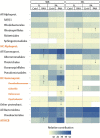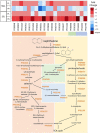Polycyclic Aromatic Hydrocarbon Degradation in the Sea-Surface Microlayer at Coastal Antarctica
- PMID: 35910648
- PMCID: PMC9329070
- DOI: 10.3389/fmicb.2022.907265
Polycyclic Aromatic Hydrocarbon Degradation in the Sea-Surface Microlayer at Coastal Antarctica
Abstract
As much as 400 Tg of carbon from airborne semivolatile aromatic hydrocarbons is deposited to the oceans every year, the largest identified source of anthropogenic organic carbon to the ocean. Microbial degradation is a key sink of these pollutants in surface waters, but has received little attention in polar environments. We have challenged Antarctic microbial communities from the sea-surface microlayer (SML) and the subsurface layer (SSL) with polycyclic aromatic hydrocarbons (PAHs) at environmentally relevant concentrations. PAH degradation rates and the microbial responses at both taxonomical and functional levels were assessed. Evidence for faster removal rates was observed in the SML, with rates 2.6-fold higher than in the SSL. In the SML, the highest removal rates were observed for the more hydrophobic and particle-bound PAHs. After 24 h of PAHs exposure, particle-associated bacteria in the SML showed the highest number of significant changes in their composition. These included significant enrichments of several hydrocarbonoclastic bacteria, especially the fast-growing genera Pseudoalteromonas, which increased their relative abundances by eightfold. Simultaneous metatranscriptomic analysis showed that the free-living fraction of SML was the most active fraction, especially for members of the order Alteromonadales, which includes Pseudoalteromonas. Their key role in PAHs biodegradation in polar environments should be elucidated in further studies. This study highlights the relevant role of bacterial populations inhabiting the sea-surface microlayer, especially the particle-associated habitat, as relevant bioreactors for the removal of aromatic hydrocarbons in the oceans.
Keywords: Alteromonadales; PAH; PAH biodegradation; coastal Antarctica; hydrocarbonoclastic bacteria; sea-surface microlayer.
Copyright © 2022 Martinez-Varela, Casas, Berrojalbiz, Piña, Dachs and Vila-Costa.
Conflict of interest statement
The authors declare that the research was conducted in the absence of any commercial or financial relationships that could be construed as a potential conflict of interest.
Figures




Similar articles
-
Large Enrichment of Anthropogenic Organic Matter Degrading Bacteria in the Sea-Surface Microlayer at Coastal Livingston Island (Antarctica).Front Microbiol. 2020 Sep 11;11:571983. doi: 10.3389/fmicb.2020.571983. eCollection 2020. Front Microbiol. 2020. PMID: 33013806 Free PMC article.
-
Metatranscriptomic responses and microbial degradation of background polycyclic aromatic hydrocarbons in the coastal Mediterranean and Antarctica.Environ Sci Pollut Res Int. 2023 Dec;30(57):119988-119999. doi: 10.1007/s11356-023-30650-1. Epub 2023 Nov 7. Environ Sci Pollut Res Int. 2023. PMID: 37934408 Free PMC article.
-
Enrichment of organic pollutants in the sea surface microlayer (SML) at Terra Nova Bay, Antarctica: influence of SML on superficial snow composition.J Environ Monit. 2005 Dec;7(12):1305-12. doi: 10.1039/b507321a. Epub 2005 Oct 19. J Environ Monit. 2005. PMID: 16307088
-
A review of pollutants in the sea-surface microlayer (SML): a unique habitat for marine organisms.Mar Pollut Bull. 2004 Jun;48(11-12):1016-30. doi: 10.1016/j.marpolbul.2004.03.016. Mar Pollut Bull. 2004. PMID: 15172807 Review.
-
Anaerobic Microbial Degradation of Polycyclic Aromatic Hydrocarbons: A Comprehensive Review.Rev Environ Contam Toxicol. 2020;251:25-108. doi: 10.1007/398_2019_29. Rev Environ Contam Toxicol. 2020. PMID: 31011832 Review.
Cited by
-
Snow-Dependent Biogeochemical Cycling of Polycyclic Aromatic Hydrocarbons at Coastal Antarctica.Environ Sci Technol. 2023 Jan 31;57(4):1625-1636. doi: 10.1021/acs.est.2c05583. Epub 2023 Jan 19. Environ Sci Technol. 2023. PMID: 36655903 Free PMC article.
References
-
- Abdel-Shafy H. I., Mansour M. S. M. (2016). A review on polycyclic aromatic hydrocarbons: source, environmental impact, effect on human health and remediation. Egypt J. Pet. 25 107–123.
-
- Axelman J., Broman D., Näf C. (1997). Field measurements of PCB partitioning between water and planktonic organisms: influence of growth, particle size, and solute-solvent interactions. Environ. Sci. Technol. 31 665–669.
-
- Balmer J. E., Hung H., Yu Y., Letcher R. J., Muir D. C. G. (2019). Sources and environmental fate of pyrogenic polycyclic aromatic hydrocarbons (PAHs) in the Arctic. Emerg. Contam. 5 128–142.
LinkOut - more resources
Full Text Sources
Research Materials
Miscellaneous

